
John de Havering (died 1309), Lord of Grafton was an English military and civil servant. He was considered one of the most experienced administrators of King Edward I, serving as Seneschal of Gascony and as Justiciar of North Wales.

John de Havering (died 1309), Lord of Grafton was an English military and civil servant. He was considered one of the most experienced administrators of King Edward I, serving as Seneschal of Gascony and as Justiciar of North Wales.
John de Havering [1] was a son of Richard de Havering, who was steward of the estates of Simon de Montfort, 6th Earl of Leicester. His father died in 1267, whereupon de Havering inherited his possessions. [2] During the reign of King Henry III he was Lord of Grafton in Northamptonshire. [3]
From October 1274 to October 1278, de Havering served as Sheriff of Hampshire. After the Conquest of Wales, he became Deputy Justiciar of North Wales in 1284. [4] In July 1287 he was one of the commanders of the army, which suppressed the rebellion of the Welsh lord Rhys ap Maredudd. [5] After the suppression of the rebellion Havering was replaced in November 1287 as Justiciar and travelled with the king into Gascony.
Before returning to England in the summer of 1289, Edward I appointed de Havering Seneschal of Gascony. Right at the beginning of his tenure, Havering interfered in the administration of Bordeaux. The angry citizens turned to the Parlement of Paris, the tribunal of the French kings who were chief lords of Gascony. As a countermeasure, Havering seized wine that was to be exported to England. As early as 1290 Edward I started getting disturbing news from Gascony, and on actually going over there in 1294, he found numerous local barons and citizens dissatisfied with the English administration. [1]
In 1294, Havering returned to England, where the king summoned him to a gathering of English prelates. Speaking as the King's representative, Havering threatened the clergy with outlawry if they did not grant higher taxes. [6] During the Welsh Rebellion from 1294 to 1295 he was charged with the defence of Merionethshire. [7] In 1295, the rebel leader Madog ap Llywelyn surrendered to him, which is why he claimed the reward of 500 marks on the capture of Madog. [8] From 1295 to 1301 he served as Justiciar of North Wales, [9] while he was to investigate the causes of the rebellion. However, he showed little compassion for the Welsh people, who were dissatisfied with the high levies and forced recruitment of soldiers for the king's wars. [10] In 1299, Havering was summoned by the King to Parliament. [2]
In 1305, Havering was again appointed seneschal of Gascony, which had been occupied during the war with France and largely by France. In 1303, Havering returned to the English administration. His son, Richard de Havering, accompanied him to France and served as commander of Bordeaux. As a seneschal, Havering had but little income and only limited jurisdiction. Therefore, he had trouble ending the feuds between the Sire d'Albret and the Sire de Caumont and between Count Gaston of Foix and Count Bernard of Armagnac. In April 1306, Edward I transferred the Duchy of Aquitaine including Gascony to the heir to the throne Edward before his own death in 1307. Havering was replaced in 1308 as Seneschal. [11]
Havering apparently died around 1309. His widow Margaret still owned in 1336 estates in Essex and Hertfordshire. [3] Havering's heir was his son Richard de Havering, Archbishop of Dublin. [12]

Edward I, also known as Edward Longshanks and the Hammer of the Scots, was King of England from 1272 to 1307. Concurrently, he was Lord of Ireland, and from 1254 to 1306 he ruled Gascony as Duke of Aquitaine in his capacity as a vassal of the French king. Before his accession to the throne, he was commonly referred to as the Lord Edward. The eldest son of Henry III, Edward was involved from an early age in the political intrigues of his father's reign. In 1259, he briefly sided with a baronial reform movement, supporting the Provisions of Oxford. After reconciliation with his father, he remained loyal throughout the subsequent armed conflict, known as the Second Barons' War. After the Battle of Lewes, Edward was held hostage by the rebellious barons, but escaped after a few months and defeated the baronial leader Simon de Montfort at the Battle of Evesham in 1265. Within two years, the rebellion was extinguished and, with England pacified, Edward left to join the Ninth Crusade to the Holy Land in 1270. He was on his way home in 1272 when he was informed of his father's death. Making a slow return, he reached England in 1274 and was crowned at Westminster Abbey.
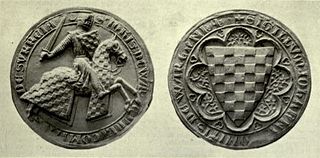
John de Warenne, 6th Earl of Surrey was a prominent English nobleman and military commander during the reigns of Henry III of England and Edward I of England. During the Second Barons' War he switched sides twice, ending up in support of the king, for whose capture he was present at Lewes in 1264. Warenne was later appointed as "warden of the kingdom and land of Scotland" and featured prominently in Edward I's wars in Scotland.

Madog ap Llywelyn was the leader of the Welsh revolt of 1294–95 against English rule in Wales. The revolt was surpassed in longevity only by the revolt of Owain Glyndŵr in the 15th century. Madog belonged to a junior branch of the House of Aberffraw and was a distant relation of Llywelyn ap Gruffudd, the last recognised native Prince of Wales. During his revolt, Madog issued a land grant in which he used the title "Prince of Wales".
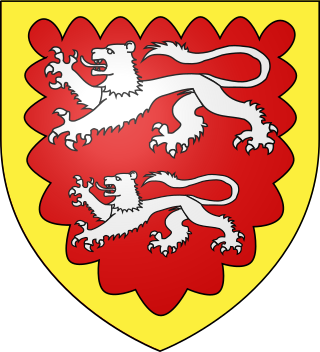
Roger le Strange, Baron Strange, also known as Roger Lestrange or Roger Strange, Lord of Ellesmere, was an English knight, commander and royal advisor.
This article is about the particular significance of the century 1201–1300 to Wales and its people.
Events from the 1290s in England.
Morgan ap Maredudd sometimes referred to as “Morgan the Rebel”, rebel, of Glamorgan.

Luke de Tany was an English noble. He was once the Seneschal of Gascony and Constable of Tickhill Castle and Knaresborough Castle. He served Edward I during his conquest of Wales by successfully capturing Anglesey in 1282. From Anglesey, de Tany sent a strong force over the Menai Strait where they were defeated at the Battle of Moel-y-don.
Tudur Hen or Tudur ap Goronwy was a Welsh aristocrat and original founder of the House of Tudor. He was one of three sons of Goronwy ab Ednyfed who received lands from King Edward I of England. Nonetheless, he backed the rebellion of Madog ap Llywelyn, but afterwards swore allegiance to both Edward I and his son, Edward of Caernarfon. Tudur Hen was responsible for the restoration of the Franciscan friary at Bangor, where his body was later placed on 11 October 1311.
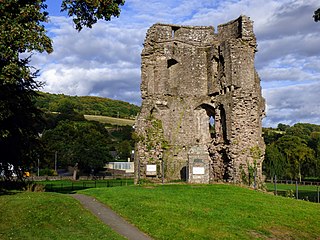
Crickhowell Castle is a Grade I listed building in Crickhowell, Wales, now largely ruined. An alternative name, "Alisby's Castle", is sometimes used; this is thought to be after a former governor of the castle, Gerald Alisby.
The Lieutenant of the Duchy of Aquitaine was an officer charged with governing the Duchy of Aquitaine on behalf of the King of England. Unlike the seneschalcy of Gascony, the lieutenancy was not a permanent office. Lieutenants were appointed in times of emergency, due either to an external threat or internal unrest. The lieutenant had quasi-viceregal authority and so was usually a man of high rank, usually English and often of the royal family.

Edward I of England was associated with a faction of nobles and knights who came from the County of Savoy, and were favoured in England. Savoy became linked to the Plantaganet monarchy of England with the marriage of Edward I's parents Henry III of England and Eleanor of Provence in 1236. Eleanor of Provence was the daughter of Beatrice of Savoy.
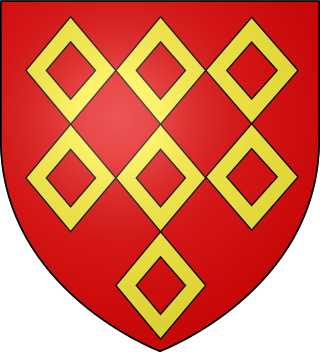
William Ferrers, 1st Baron Ferrers of Groby was an English peer who lived under two kings, Edward I and Edward II. His baronial caput was Groby in Leicestershire.
The Gascon campaign of 1294 to 1303 was a military conflict between English and French forces over the Duchy of Aquitaine, including the Duchy of Gascony. The Duchy of Aquitaine was held in fief by King Edward I of England as a vassal of King Philip IV of France. Starting with a fishing fleet dispute and then naval warfare, the conflict escalated to open warfare between the two countries. In spite of a French military victory on the ground, the war ended when the Treaty of Paris was signed in 1303, which restored the status quo. The war was a premise to future tensions between the two nations culminating in the Hundred Years' War.
The Seneschal of Gascony was an officer carrying out and managing the domestic affairs of the lord of the Duchy of Gascony. During the course of the twelfth century, the seneschalship, also became an office of military command. After 1360, the officer was the Seneschal of Aquitaine. There was an office above the seneschalcy, the Lieutenancy of the Duchy of Aquitaine, but it was filled only intermittently.

John de Vaux also known as John de Vallibus was a 13th-century English nobleman.
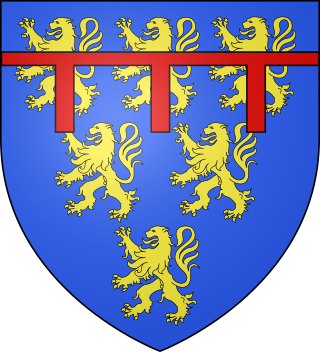
Stephen Longespée was an English knight who served as Seneschal of Gascony and as Justiciar of Ireland.

Hugh de Turberville was an English noble and soldier.
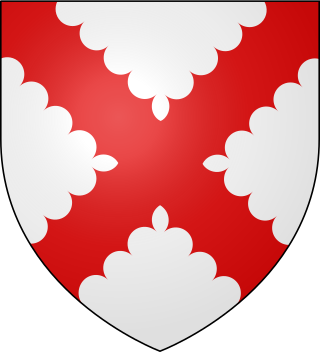
Robert de Tiptoft, Lord of Nettlestead, Carbrooke and Langar, was an Anglo-Norman landowner and soldier.

A series of Welsh rebellions broke out in the century following the conquest of Wales by Edward I in 1283, which had brought the whole of Wales under the control of the Kingdom of England for the first time. In 1400, Welsh discontent with English rule in Wales culminated in the Welsh Revolt, a major uprising led by Owain Glyndŵr, who achieved de facto control over much of the country in the following years. The rebellion petered out after 1409, and after complete English control was restored in 1415 no further major rebellions occurred.